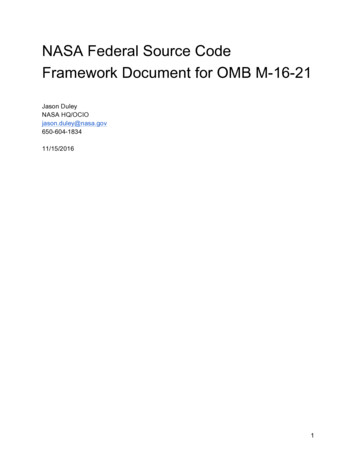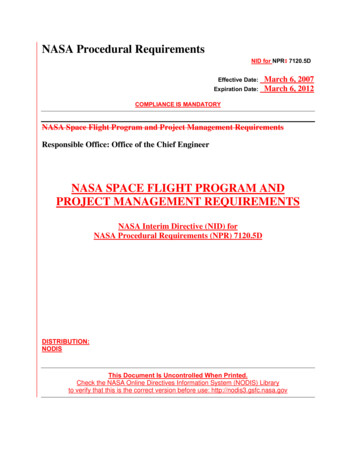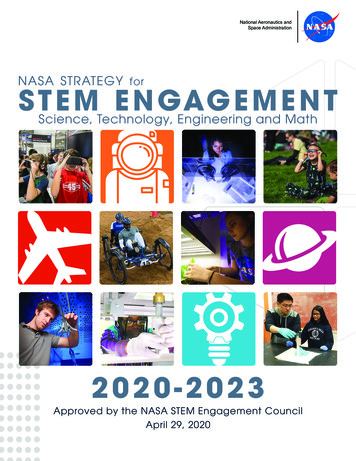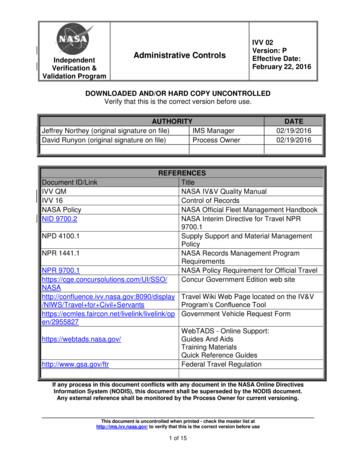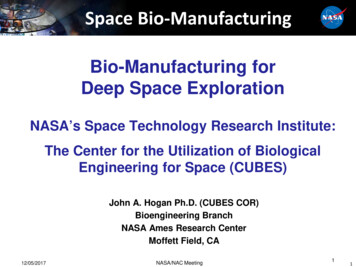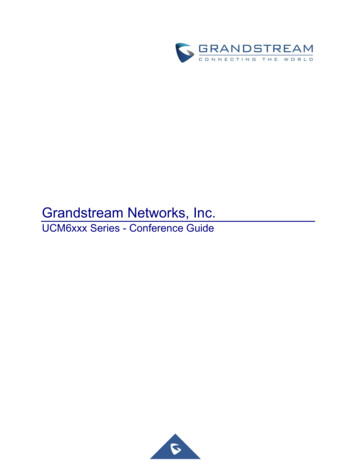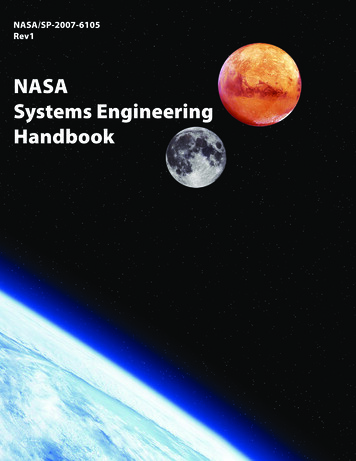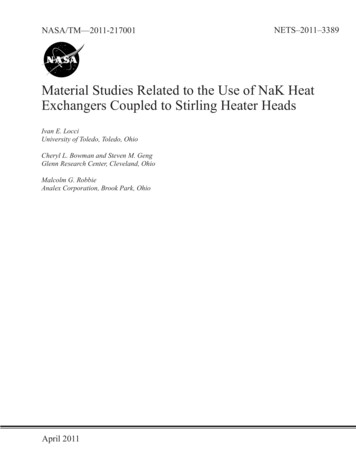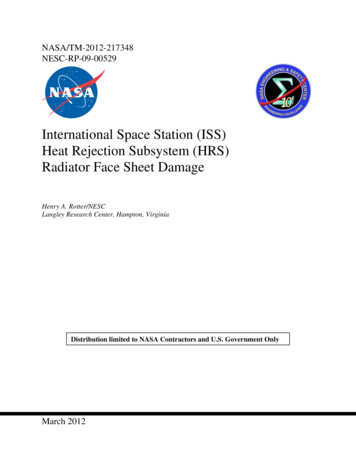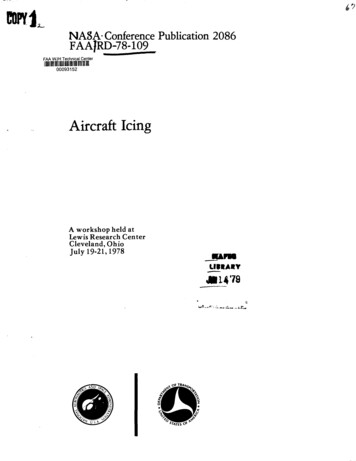
Transcription
NASA· Conference Publication 2086FAAJRD-78-109FAA WJH Technical lll00093152Aircraft IcingA workshop held atLewis Research CenterCleveland, OhioJuly 19-21, 1978.--LIIIAIYMl4'79I;-.,:f . .-11··, .:. . - - .L.c. -
ORGANIZATION COMMITTEEJohn H. EndersNASA HeadquartersWashington, D.C.Arthur HilsenrodFederal Aviation AdministrationWashington, D.C.Lt. Col. George W. SibertDepartment of the ArmyWashington, D.C.Milton A. BeheimNASA Lewis Research CenterCleveland, OhioJ. B. McColloughFederal Aviation AdministrationWashington, D.C.Lt. Col. Thomas C. WestFederal Aviation AdministrationWashington, D.C.John F. WardNASA HeadquartersWashington, D.C.Dennis W. CampNASA George C. Marshall Space Flight CenterMarshall Space Flight Center,.Alabama
NASA Conference Publication 2086FAA-RD-78-109Aircraft IcingA workshop sponsored byNational Aeronautics andSpace Administrationand Federal AviationAdministration, Washington,D.C., and held atLewis Research Center,Cleveland, OhioJuly 19-21, 1978N/\5/\National Aeronautics andSpace AdministrationScientific and TechnicalInformation Office1979
WELCOMING REMARKSDr. Bernard LubarskyDeputy DirectorNASA Lewis Research CenterGood morning! It is my pleasure to welcome the Icing Workshop tothe Lewis Research Center. I'm impressed with the renewed interest inicing as represented by the size of this group, and by the attendanceof many guests from other countries. If this meeting had been organized a few years ago, I believe we could have all sat around a cardtable.Lewis was very active in icing research through the 19 0's andearly SO's. In this time period, de-icing techniques suitable forlarge commercial transports were developed in our Icing ResearchTunnel which contributed to the all weather operation of current transports. This research effort was terminated in the late 1950's andsubsequently the only remaining activity was to provide operationalsupport of the tunnel at the request of other government agencies andtheir contractors. Within the past few years, this low level of efforthas expanded to the point where it is difficult to satisfy all therequests for testing in the Icing Research Tunnel. This renewedinterest is driven by both new requirements and new opportunitiesoffered by improved technology developed in recent years. These newrequirements encompass the need to obtain an all weather capabilityfor helicopters and general aviation aircraft, and the desire toachieve more efficient equipment for commercial transports.The interests in achieving all weather operation of helicoptersare to meet both a military requirement to operate over Europe duringthe winter and a commercial requirement to service oil rigs in theNorth Sea and off Alaskan shores. This capability would almost certainly find additional commercial uses once it is demonstrated. Thehelicopter lacks the large power and heat sources that are used on acommercial transport to de-ice the aircraft. Therefore, improvedtechniques are required that are lower power, lighter weight, andlower cost.The advances achieved in avionics make all weather generalaviation a real possibility for the future. Since its payload capability (like that of the helicopter) is relatively small, presentmethods of ice protection impose serious penalities on its capabilities. Improved ice protection techniques with characteristics similarto those required for helicopters are clearly needed.iii
Although the icing program of the 19 0's addressed principally theneeds of CTOL aircraft in that time period, the revolutionary changesin CTOL aircraft for the 1970's and 80's have created new designvariables and operational conditions that were never considered in theearlier work.New technology which has evolved in the past decade can providenew tools in achieving solutions to these icing problems. For example,new de-icing techniques that have been proposed in recent yearsinclude microwave and electromagnetic impulse methods that are potentially lighter and lower in power than current methods. Results fromthe continuing evolution of ice-phobic materials also need to beassessed periodically for aircraft applications. New instrumentationsuch as lasers provide the means to define the testing conditions andicing environment more accurately. Also, new methods in computationalfluid dynamic analysis can provide better predictions of ice collectionrates and ice shapes.I'm pleased to see the renewed interest in icing and wish you asuccessful workshop. I look forward to reviewing your recommendations.iv
CONTENTSPageWELCOMING REMARKSDr. Bernard Lubarsky, NASA Lewis Research Center . . . . iiiINTRODUCTIONJohn H. Enders, NASA Headquarters . . . . . . . .viiEXECUTIVE SUMMARY OF AIRCRAFT ICING SPECIALISTS WORKSHOPMilton A. Beheim, NASA Lewis Research Center . 1KEYNOTE PRESENTATIONSICING OF AIRCRAFT; SOME REMARKS WITH AN HISTORICAL SLANT FROMA CLOUD PHYSICISTRobert M. Cunningham, Air Force Geophysics Laboratory.SAFETY HAZARD OF AIRCRAFT ICINGJames C. McLean, Jr., National Transportation Safety BoardCIVIL HELICOPTER ICING PROBLEMSPeter B. Sweeney, RCA Flight Operations . . . . . . .A REVIEW OF THE ICING SITUATION FROM THE STANDPOINT OFGENERAL AVIATIONDennis W. Newton, Cessna Aircraft Company . . . .OVERVIEW OF HELICOPTER ICE PROTECTION SYSTEM DEVELOPMENTSRichard I. Adams, Applied Technology Laboratory, U.S. ArmyResearch and Technology Laboratories (AVRADCOM) . . . . .2129.31.39COMMITTEE GUIDELINESMETEOROLOGICAL RESEARCH COMMITTEE.ICING FORECASTING COMMITTEE . . .SYSTEMS DEVELOPMENT COMMITTEE.CIVIL OPERATIONS COMMITTEE . MILITARY OPERATIONS COMMITTEE . .ICING RESEARCH AND FACILITIES COMMITTEE .SUMMARY REPORTSMETEOROLOGICAL RESEARCH COMMITTEEHelmut K. Weickmann, NOAA, ERL, Atmospheric Physics andChemistry Laboratory . . . . . . . . .ICING FORECASTING COMMITTEEArthur Hilsenrod, Federal Aviation Administration. SYSTEMS DEVELOPMENT COMMITTEERichard L. Kurkowski, NASA Ames Research Center . CIVIL OPERATIONS COMMITTEELt. Col. Thomas C. West, Federal Aviation Administration .MILTARY OPERATIONS COMMITTEELt. Col. George W. Sibert, U.S. Army, HDQA, DAMA SA .ICING RESEARCH AND FACILITIES COMMITTEEMilton A. Beheim, NASA Lewis Research Center . .v17.6768697071727393101109115121
APPENDIXESA - AIRCRAFT ICING RESEARCH PANEL REPORT TO SAE AC-9 COMMITTEE(AIRCRAFT ENVIRONMENTAL CONTROL SYSTEMS) MAY 1978 . .B - WORKSHOP AGENDA. . .C - COMMITTEE MEMBERSHIPD - PARTICIPANTS . . .vi129137139141
INTRODUCTIONJohn H. EndersNASA HeadquartersBACKGROUNDThe recent renewal of interest in flight icing may be surprising to many,but it probably should have been expected. Our experience with safety andoperating p-roblems research has been that problems are "solved" for a time, andthen, as aircraft designs and operating practices change, these problems reemerge and call for renewed effort, often in terms of a finer-scale solutionthan was offered earlier. Icing hazards to aircraft were thoroughly researchednearly 2\ decades ago. Reports were written on icing meteorology, forecasting,ice accretion, and on ways to prevent ice formation or remove ice from surfacescritical to flight. That effort summa·I'ized pretty well what was known andunderstood at the midpoint of this century.Within a decade of completing that effort, the air carrier fleet moved into the jet age. The operations were characterized by rapid climbs with plentyof power to altitudes above most weather, including icing. Low terminal traffic densities of that day allowed a similar swift descent to landing with littledwell time at icing levels. General aviation and some military traffic continued to contend with icing problems, but they had the improved icing knowledgeof the research program to allow modest improvements in operations. Icing,from an applied aviation research standpoint, disappeared from our consciousness, except for the occasional icing-related accident.Within the past few years, several things have happened to bring about renewed interest in icing. New aerodynamic designs have emerged which raisequestions of icing vulnerability for which the existing data are inadequate.Expanded operational regimes for both civil and military rotorcraft as well asfor general aviation aircraft have increased the exposures of these two classesof aircraft to icing threats at a point in flight vehicle development and usewhere expectations of operational dispatch reliability and dependability arehigh.WORKSHOP OBJECTIVESA steady increase in the number of questions on icing vulnerability coupled with an intensified icing test schedule prompted NASA and FAA, with theplanning assistance of DOD, to sponsor this Aircraft Icing Specialists Workshop. The objectives of the Workshop were as follows:(1) To assess the current understanding of fixed wing and rotorcraft operational icing environments and problemsvii
(2) To evaluate facilities requirements for R&D and certification purposes(3) To examine means of improving icing forecasts(4) To identify shortcomings in aeronautical icing knowledge which can bealleviated by new research and instrumentation developmentTo achieve these objectives, a representative cross section of knowledgeable icing specialists in the aviation community were invited to participate inthis Workshop. The 113 experts who attended came from various countriesthroughout the free world and included icing researchers; meteorologists andforecasters; sensor/instrument specialists; general aviation, transport, androtorcraft airframe and engine manufacturers; and civil and military operatorsand pilots. In this way, the broadest possible view of the icing problem wasobtained, and wherever possible, concensus views of desirable and necessaryfuture action with regard to operating in icing conditions were obtained.Since the intent of this Workshop was to share information from a widerange of specialist groups, most of whom normally have little or no regularcontact with one another, the Organization Committee decided on an interactiveformat for the meeting. This format provided opportunities for some structuredstate-of-art overviews of certain icing topics along with group and one-on-onediscussions during the three-day meeting. An exchange of ideas, thoughts, andinformation resulted that could never have been attained from conferences orsymposia.WORKSHOP PROCEDURESEach participant was assigned to one of six committees. Each committeewas assigned a specific area of interest in order to provide a broad, structured spectrum within which the many icing subtopics could be addressed. Eachcommittee chairman organized and guided his committee in its interactions. TheOrganization Committee formulated a set of guidelines for each committee consisting of a list of objectives and representative questions tailored to eachcommittee's particular interest. The questions were formulated to facilitatethe interactive discussions across the specialist group interest lines. Theguidelines furnished to the committees are presented on pages 67 to 72.This Workshop began with welcoming and introductory remarks. The overviewpapers that followed addressed the recent progress in several areas of aircrafticing and icing meteorology. Following these presentations, each committee metto discuss its objectives and to establish a collective reference point for theinteractive sessions that followed during the next day and a half. The meetingschedule (p. ix) shows how the committees interacted so that every participanthad opportunities to give and receive views on all topics. On the final morning the committees again met individually to assemble their committee reports.A final plenary session provided time to present the committee reports to theassembly and for general discussion. The keynote presentations·and the committee reports are followed in this publication by appendixes that contain an additional report pertinent to the theme of this Workshop, the Workshop agenda, aviii
list of the committees with their members and chairmen, and a list of the Workshop participants.During the Workshop the attendees toured the Lewis Icing Research Tunnel(IRT) and the Lewis Altitude Wind Tunnel, which has been proposed for modification into a Large Subsonic Propulsion and Icing Test Facility.COMMITTEE MEETING SCHEDULECommitteeChairmanMET - Meteorological ResearchDr. Helmut WeickmannFOR - Icing ForecastingMr. Arthur HilsenrodDEV - Systems DevelopmentMr. Richard L. KurkowskiCO - Civil OperationsLt. Col. Thomas WestMO - Military OperationsLt. Col. George W. SibertFAC - Icing Research and FacilitiesMr. Milton A. BeheimSession.RoomAdministration /lOxlO SWT,room 106or 100CommitteePanel organizationWed., 1:00 - 2:30pmMETFirst sessionWed., 3:00 - 4:30 pmcoSecond sessionThurs., 8:159:45 amcoThird sessionThurs., 10:00-11:30 amcoFourth sessionThurs., 1:00 - 2:30pmco 1-Fifth sessionThurs., 3:00 - 4:30 pmPanel report preparationFri., 8:00 - 9:30 --.--DEV/coMO.METFORDEV/FAC-----------FAC
EXECUTIVE SUMMARY OF AIRCRAFT ICING SPECIALISTS WORKSHOPMilton A. BeheimNASA Lewis Research CenterHISTORICAL PERSPECTIVEAn important chapter in the historical evolution of aircraft is that related to icing research. From 1940 to 1955 the particularly significant efforts made in industry and at government laboratories (particularly NACA) weredirected toward defining the natural icing environment, determining its effectson representative aircraft components, and designing techniques for ice protection concepts. The results established a basis for certification criteria andmeteorological reporting procedures that proved to be generally acceptable toachieve all-weather capability for the large transport aircraft of that time.When this effort ended in the late 1950's, the principal emphasis in the designof transport aircraft had shifted to jet power. Because of higher installedpower and high cruise altitudes, these jet aircraft were exposed less to ice.In fact, they were even more ice-tolerant than propeller transports. The majormanufacturers of these aircraft continued to develop increasingly sophisticatedanalysis and testing techniques for icing protection that were tailored to thespecific aircraft being certified. Although the certification criteria weregenerally recognized to be conservative, the penalties to aircraft-performanceand cost were not excessive since large quantities of heated, high-pressure airwere readily available from their powerplants for ice protection systems on theengines and airframe. For many components of such aircraft it even became possible to eliminate the ice protection systems entirely simply because theirphysical size was so large that ice accretion was minor in extent and the resulting aerodynamic influence was acceptably low.This trend in the design of new large transport aircraft continues to thepresent day. However, in a period of escalating development costs for new aircraft, there is growing interest in a renewed and coordinated icing researcheffort to achieve an updating or modernization of each aspect of the technological issues that are involved. This includes the data base, analysis methods,test teChniques, and test facilities.In recent years it has become necessary to extend the icing technology toentirely new classes of aircraft: rotorcraft and general aviation. The emerging "small transport" aircraft, the proposed FAR Part 24 airplane, may operatemore frequently in icing environments than the large jet transport. The advances achieved in avionics now provide the opportunity to operate in severeweather with these smaller aircraft as well as with the large transports. However, the icing protection requirements for these small aircraft are so uniquely different from those for large transports that an extrapolation of the current base of icing teChnology is clearly inadequate. The components of theseaircraft are smaller so proportionately heavier accretions of ice are more likely to occur. Consequently, their aerodynamic performance will deteriorate more
drastically. Penalties for the weight of icing protection systems are alsomore severe since the payload fraction of these aircraft is already relativelylow. In addition, their engines differ in cycle characteristics so large quantities of high pressure heated air are not readily available for ice protection.Consequently, the technological issues requiring modernization not only includethose listed earlier for transport aircraft but they also extend to unconventional ice protection concepts.Furthermore, to avoid undue penalties in design and operation, the certification criteria and weather reporting procedures for large transport aircraftneed to be reexamined for their applicability to small aircraft.OVERVIEW OF ICING EFFECTS ON AIRCRAFT DESIGNAn important step in the design of aircraft for operation in icing conditions is to establish the nature of the most severe icing encounter that may beexpected. Although the detailed character of the natural icing environment iscomplex, the principal parameters are air temperature, liquid water content,and mean drop size. Extreme values for combinations of these parameters arethe basis for certification criteria, and they were derived from statisticalanalyses of rather limited flight data. A typical example is shown in figure 1.The accretion of ice on an object in an air stream depends on the quantityof water that strikes its surface. When the drops are small compared with thesize of the body they tend to follow the flow streamlines around the body andfew drops strike its surface. Conversely, when the drops are relatively largethey tend to follow straight lines and so impact on the frontal body area.Consequently, larger, blunter bodies collect relatively less ice than smaller,sharper bodies. This effect is illustrated in figure 2. The accretion of icefurther depends on surface heat-transfer balances involving phase changes andlocal heat-transfer rates. Analytical models of these conditions are used extensively throughout the development process for the aircraft and its ice protection system.The resulting shape of the ice cap depends on the influence of the localflow field in distributing the liquid water over the surface before it freezes.Hence, the rate of freezing is important and so is the distorted shape of thesurface that results from the prior accumulation of the growing ice cap. Atlow temperatures where freezing is rapid, a type of ice called rime forms astreamline shape. For warmer conditions, the water film flows more extensivelybefore freezing and a type of ice called glaze freezes in a horn shape. Representative formations are shown in figure 3. Aerodynamic effects of the ice capare evaluated by means of artificial ice in an icing wind tunnel, by simulatedice in conventional wind tunnel or flight test programs, or by flying in naturalicing conditions.The principal effects of ice accretion on an aircraft are to decrease pilotvisibility, increase weight, reduce aerodynamic performance (such as lower stalllimits or lift to drag ratio), or cause structural damage to critical componentssuch as that damage resulting from the ingestion of ice into turbine engines.2
The consequences of the latter are so severe that the propulsion system meritstop priority for icing protection. Although the degradation of the aerodynamicperformance of airframe components varies considerably depending on the component in question, the consequences are potentially of such great importance toaircraft safety that a careful evaluation of icing effects is required in thedesign and development process. Assessments of these effects determine the extent of icing protection that is selected for a specific aircraft. Two different means for icing protection are common: an anti-icing system is in continuous operation to prevent ice accretion, and a deicing system is operated intermittenly to shed ice after it has developed to a predetermined limit. Deicinghas an advantage in reducing the total energy required and thermal systems canbe employed. Common means of thermal protection employ heated air ducts orelectric resistance heaters located in the component being protected. An alternate approach is a mechanical system using a pneumatic boot which is inflatedperiodically to break loose the ice cap. Each method offers unique advantagesand disadvantages. The disadvantages, which become more obvious in applicationsto small aircraft or rotorcraft, are evident in terms of high initial and maintenance costs, excessive weight and power requirements, and marginal effectiveness and reliability. To verify that a particular aircraft design is suitablefor operation in icing conditions, a flight test program is normally requiredin the natural icing environment. However, because of the difficulties encountered in locating severe natural icing conditions with a test aircraft, artificial icing tests using tanker aircraft and ground test facilities (icing windtunnels and engine test cells) play an important role. Certification is thenaccomplished by a composite analysis and extrapolation of data from all sources.The artificial icing tests verify the limits of specific systems, and the natural icing tests ensure that nothing has been overlooked.ICING RESEARCH NEEDSThe principal areas where further research is required are summarized intable I. The top portion indicates those technical subjects which are of broadand general interest regardless of the type of aircraft being considered. Thebottom portion identifies specific applications of this generalized technologythat pertain to aircraft components that are unique to a particular aircraftconcept.GENERALIZED TECHNOLOGYMeteorologyTable I indicates the four major needs in meteorology that have generalapplicability in all aircraft icing situations.Cloud physics. - A fundamental aspect ofunderlies success in all aspects of the icingof cloud physics. Not only does it influenceforecasting the icing environment, but it can3meteorological research thatproblem is a sufficient knowledgethe techniques for measuring andalso influence the appropriate
mode of flight operations. The most significant effort in recent years thatrelates to cloud physics was directed toward weather modification objectives.Since these weather conditions are closely related to those causing icing conditions, it appears appropriate to reexamine the results of that effort for itsapplicability to icing research. In particular, it could provide better insight into the finer scale structure of icing clouds. Although this structuremay be of lesser importance for high-speed transport aircraft, it can be verysignificant for low-speed aircraft such as rotorcraft.Icing environment. - Another aspect of meteorological research is the definition of the natural icing environment that is encountered during flight.The parameters of interest are the extreme values of liquid water content andthe mean drop size for various values of outside air temperature. Appropriatecombinations of these parameters are established for two different cloud formations: stratiform and cumulus. The values currently being used were developedfrom a statistical analysis of several hundred flight observations that weremade of natural icing conditions in the late 1940's and early 1950's. Althoughthese extreme conditions were used as an interim definition of the environmentpending further vertification at a later date, it was never done. Consequently,several questions exist today regarding the validity of these definitions ofthe icing environment for application to future aircraft. In particular, thefollowing limitations exist:(1) The older measurements have been extrapolated to an accuracy that exceeds the statistical accuracy of the data.(2) The accuracy of the older measurement techniques are questioned inlight of recent work using modern instrumentation.(3) The range of altitudes for the old data (from 4000 to 20,000 feet) istoo restricted for new types of aircraft.(4) Extrapolations of these data to low altitudes are now known to bephysically unrealistic.(5) The horizontal extent of the icing cloud has not been adequately defined.(6) The ground cloud parameters have not been determined.(7) The fine grain structure of the icing cloud and hence the time dependent characteristics resulting from flight through it have not been defined.(8) The parameters for defining the mixed conditions of ice particles andsupercooled water have not been established.These limitations are generally viewed as having created an overly conservativeview of the icing environment. Although this conservatism may be tolerable forlarge transport aircraft, the penalties for small aircraft and rotorcraft canbe excessive; consequently, a renewed research effort is justified. 4
Forecasting. - A third requirement is improved weather reporting and forecasting procedures and techniques. The present system of reporting relies entirely on qualitative terms (such as light or severe) that do not recognize thevarying susceptibility of different aircraft designs to identical icing environments. For example, light icing for a large transport could be severe for asmall airplane. The only reasonable alternative to this problem is to introduce quantitative terms so that an aircraft operator can make operational decisions that are the most appropriate for his own particular aircraft. Althougha knowledge of all three icing parameters (water content, air temperature, anddrop size) are very much desired, it is evident that drop size is the hardestto measure with present instrumentation and weather observation techniques.However, a knowledge of the other parameters which are more easily measuredwould greatly enhance the operational capabilities of smaller aircraft.Remote observation. - The need for techniques for the remote observationof weather conditions in terms that can be interpreted to infer icing conditions is clearly evident. One type of observation that is needed is a largescale view of weather patterns so that the location and extent of icing conditions can be identified and reported. One such approach is to use an airborneautomated icing observation system. A second type of observation is a morelocalized measurement that can be made from individual aircraft so that a "lookahead" capability can be used to select the best flight profile when an icingcondition must be entered. It is not yet evident which observation techniquesare most suitable for these requirements, but radar or microwave concepts offersome potential.AircraftThe next portion of table I relates to generalized technology, and it indicates four important research areas in the design, development, and operationof aircraft.Ice accretion. - The first area deals with the nature of ice accretion ona variety of geometric shapes. Earlier work in the 1940's identified the general character of these ice formations and their sensitivity to icing parameters. Effective means of analyzing water impingement and heat-transfer effectswere evolved in the 1950's so that predictive methods became useful in caseswhere two-dimensional flow effects were dominant. However, most modern aircraftflow fields exhibit important three-dimensional characteristics. In addition,predictive methods for the ice cap geometry and its influence on the flow fieldare not well developed because of flow separation effects. In recent years,advances in computational fluid mechanics have been achieved which potentiallycould provide major improvements in treating these effects. Further development of these analytical tools would be very useful, particularly when a decision must be made early in the design phase whether or not the accretion of iceon an aircraft component has such severe aerodynamic effects that an icing protection system is required.A second aspect of ice accretion that requires further investigation isthe scaling of the accretion process and its aerodynamic influence so that subscale model tests are developed into a more powerful tool than at present.Ground test facilities such as wind tunnels play a very important role in the5
design and development of aircraft. At the present time, however, those tunnels with the unique capabilities for icing tests are relatively small. Thelargest such tunnel in North America is the NASA Icing Research Tunnel at theLewis Research Center with a 6x9 foot test section. Although some full-scalecomponents can be tested, it is obvious that scaling techniques are required tosupport the design and development of new aircraft. This is particularly truefor aircraft with large components that also have a high sensitivity to iceaccretion such as the rotor of a helicopter.A third aspect of ice accretion which requires additional effort is thebond strength characteristics between the ice cap and the aircraft structure.The bond strength characteristics influence the shedding properties of the icecap as a consequence of aerodynamic forces, centrifugal forces, or vibratoryforces. These properties vary depending on the type of ice, the structuralmaterial and surface treatment, and the structural temperature. Although initial efforts have been made particularly with respect to the use of icephobicsurface coatings, the scope of the work should be expanded as new materials(such as composites) come into wider use and as new applications (e.g., helicopter rotors) become necessary.A fourth subject relating to ice accretion is the simulation of the icecap with model ice constructed of fiberglass, plastic, or other conventionalmaterials. Recent work in industry indicates initial success in specific applications so that simulated ice was used on conventional w
Lt. Col. Thomas West FAC - Icing Research and Facilities Lt. Col. George W. Sibert Mr. Milton A. Beheim . Session Room Administration Building lOxlO SWT, room 106 Auditorium Foyer 225 14 215 or 100 (133) Committee Panel organization MET FOR DEV co MO FAC Wed., 1:00 - 2:30pm First session co ---MO --FAC/ ---
